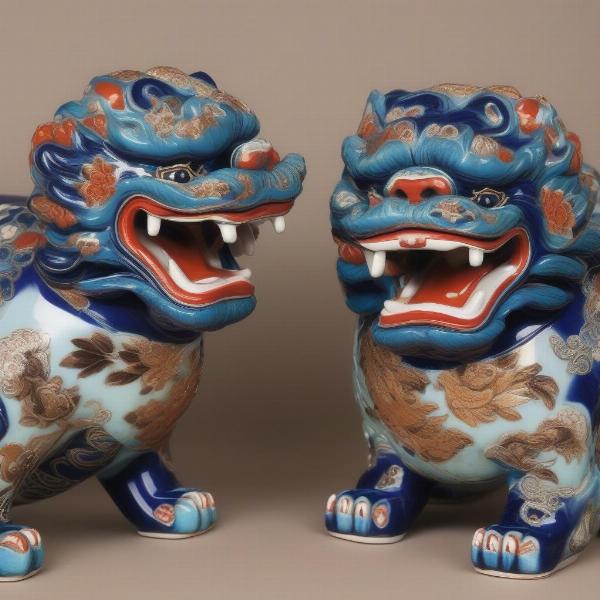Kutani foo dogs, also known as komainu in Japanese, are charming and often elaborately decorated ceramic figures that have captured the hearts of collectors and dog lovers alike. These figures are not representative of a specific dog breed but are stylized representations of lion-dogs, believed to be powerful protectors in various Asian cultures. This guide will explore the history, symbolism, and artistry of Kutani foo dogs, helping you understand their significance and appreciate their unique beauty.
Kutani foo dogs originated from the Kutani region of Japan, known for its distinctive and vibrant porcelain. These figures often come in pairs, with one typically depicted with an open mouth and the other with a closed mouth. This symbolizes the beginning and end, or inhalation and exhalation, representing the balance of life. They are frequently placed at entrances, acting as symbolic guardians of homes and sacred spaces. Their presence is believed to ward off evil spirits and invite good fortune.
Understanding the Symbolism of Kutani Foo Dogs
The symbolism of foo dogs extends beyond mere decoration. They are imbued with powerful meanings representing protection, prosperity, and spiritual balance. The open mouth is often interpreted as a symbolic roar to ward off evil, while the closed mouth symbolizes the retention of good fortune. Often, one foo dog will have a ball or a cub under its paw, representing playfulness and the continuation of life.
 Close-up detail of a Kutani foo dog pair, focusing on the open and closed mouths and intricate painted designs.
Close-up detail of a Kutani foo dog pair, focusing on the open and closed mouths and intricate painted designs.
Identifying Authentic Kutani Foo Dogs
While the popularity of Kutani foo dogs has led to numerous reproductions, authentic pieces exhibit specific characteristics. These include the distinctive overglaze painting techniques, often featuring vibrant colors like red, gold, and green. The base of the figure will typically have a Kutani mark, although these marks can vary depending on the specific kiln and era.
Collecting and Caring for Kutani Foo Dogs
Whether you’re a seasoned collector or simply drawn to their unique aesthetic, caring for your Kutani foo dogs is essential. Gentle cleaning with a soft cloth is recommended, and avoid using harsh chemicals that could damage the delicate paintwork. When displaying your foo dogs, consider their symbolic placement, traditionally at entrances or on elevated surfaces.
The Enduring Appeal of Kutani Foo Dogs
Kutani foo dogs are more than just decorative objects. They represent a rich history and cultural significance, serving as a tangible reminder of ancient traditions and beliefs. Their enduring appeal lies in their exquisite craftsmanship, symbolic power, and the touch of whimsy they bring to any space.
FAQ
- What are Kutani foo dogs made of? They are typically made of porcelain, a type of high-fired ceramic known for its durability and translucence.
- Are Kutani foo dogs always sold in pairs? While often sold in pairs, they can also be found individually.
- How can I tell if my Kutani foo dog is antique? Consulting with an expert in Asian ceramics is the best way to authenticate a piece.
- Where should I display my Kutani foo dogs? Traditionally, they are placed at entrances or on elevated surfaces.
- How do I clean my Kutani foo dogs? Gentle cleaning with a soft, dry cloth is recommended.
About ILM Dog: ILM Dog offers expert advice on all aspects of dog care, from breed selection and training to health, nutrition, and grooming. We are committed to providing dog owners with the knowledge and resources they need to ensure their furry companions live happy, healthy lives. Need help finding the perfect products for your dog? Contact us at [email protected] or +44 20-3965-8624.